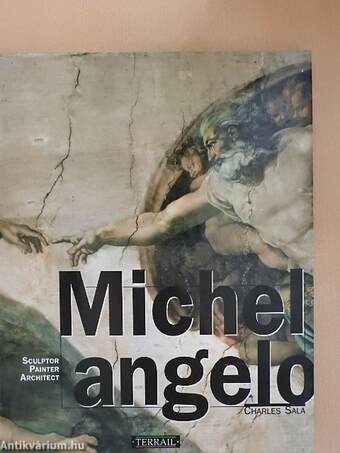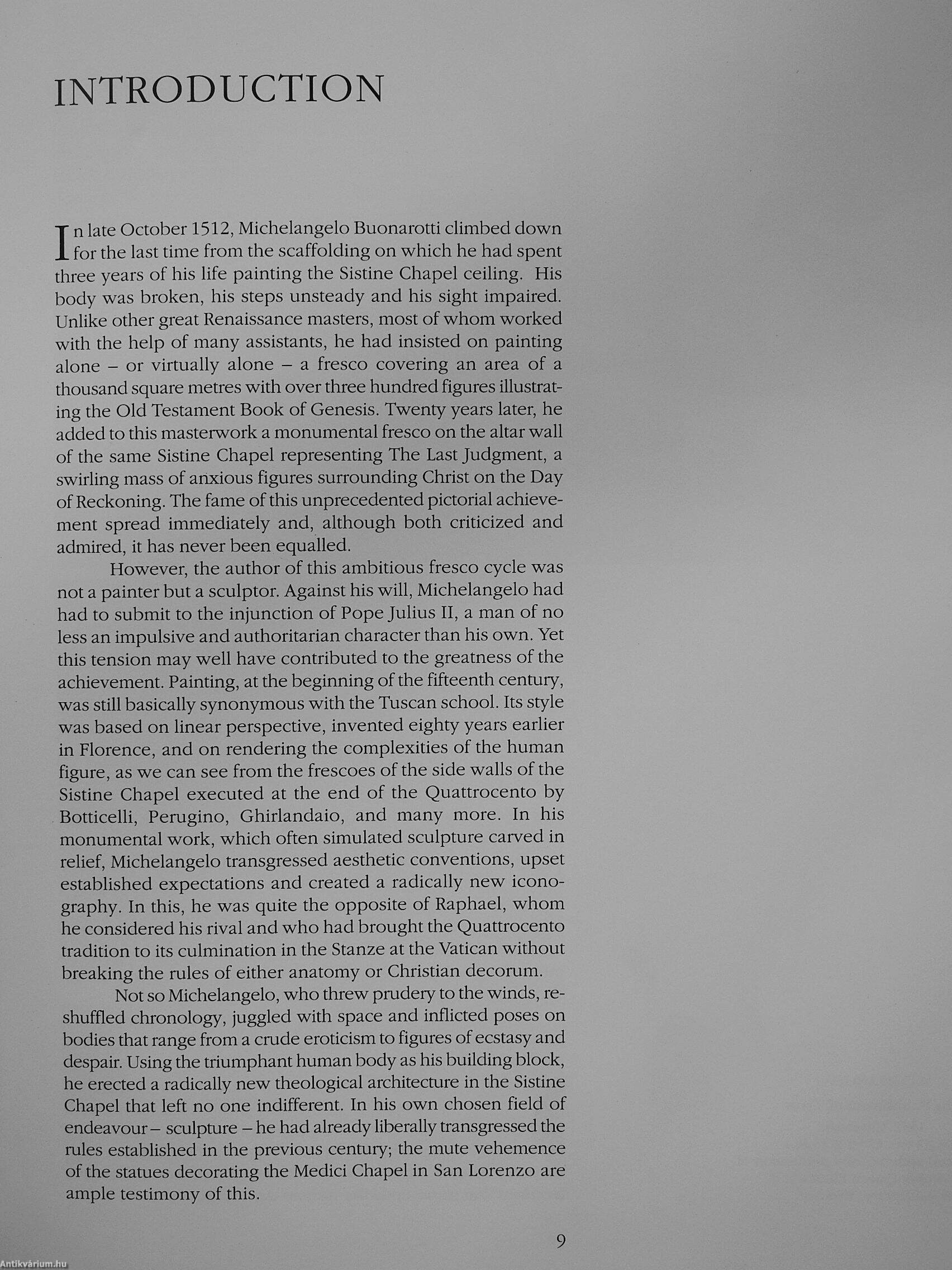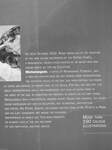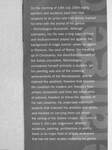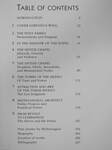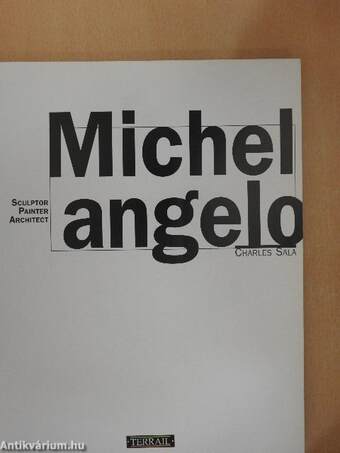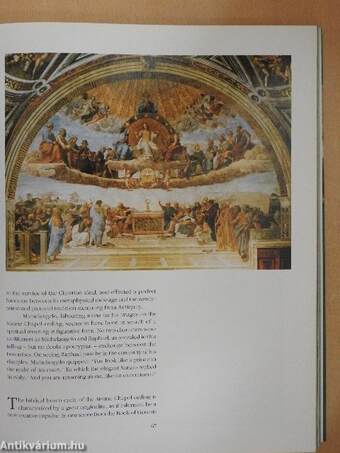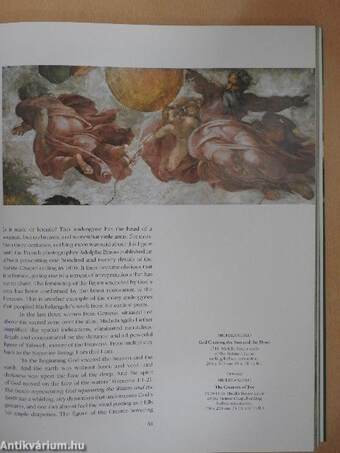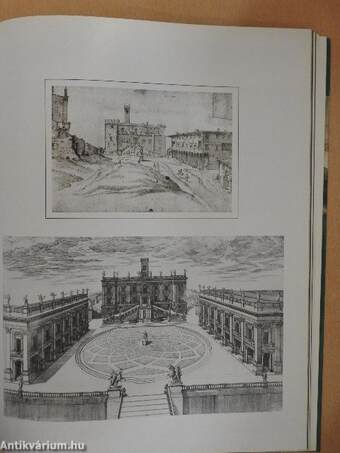1.067.317
kiadvánnyal nyújtjuk Magyarország legnagyobb antikvár könyv-kínálatát

VISSZA
A TETEJÉRE
JAVASLATOKÉszre-
vételek
Michelangelo
Sculptor - Painter - Architect
| Kiadó: | Pierre Terrail Editions |
|---|---|
| Kiadás helye: | Párizs |
| Kiadás éve: | |
| Kötés típusa: | Fűzött papírkötés |
| Oldalszám: | 207 oldal |
| Sorozatcím: | |
| Kötetszám: | |
| Nyelv: | Angol |
| Méret: | 30 cm x 24 cm |
| ISBN: | 2-87939-069-9 |
| Megjegyzés: | Színes és fekete-fehér fotókkal, reprodukciókkal illusztrálva. |
naponta értesítjük a beérkező friss
kiadványokról
naponta értesítjük a beérkező friss
kiadványokról
Előszó
TovábbFülszöveg
. On 31st October 1512, Rome marvelled at the unveiling
of the new ceiling decoration of the sistine Chapel,
a monumental fresco cycle painted by an artist who was ^^ known above all for his sculpture.
^H Michelangelo, a native of Renaissance Florence, was ^h a tireless creator who did not shrink from transgressing
the aesthetic rules of his day, nor from defying the power of popes and princes to remain true to his ideals. FOR him, art was not just about demonstrating skills and knowledge, but also of giving form to the spirit of the age. in asserting his freedom to create on his own terms, Micheungelo was a prototypical modern artist. Envied and admired, his talent found expression not only in sculpture, but in painting, architecture and poetry. HiS PlETÁS, slaves, his design for the dome of ST. PETER'S in rome and his Last Judgement are among the enduring
masterpieces of world art. this book presents an in-depth look at the life and work of this impetuous, solitary genius.... Tovább
Fülszöveg
. On 31st October 1512, Rome marvelled at the unveiling
of the new ceiling decoration of the sistine Chapel,
a monumental fresco cycle painted by an artist who was ^^ known above all for his sculpture.
^H Michelangelo, a native of Renaissance Florence, was ^h a tireless creator who did not shrink from transgressing
the aesthetic rules of his day, nor from defying the power of popes and princes to remain true to his ideals. FOR him, art was not just about demonstrating skills and knowledge, but also of giving form to the spirit of the age. in asserting his freedom to create on his own terms, Micheungelo was a prototypical modern artist. Envied and admired, his talent found expression not only in sculpture, but in painting, architecture and poetry. HiS PlETÁS, slaves, his design for the dome of ST. PETER'S in rome and his Last Judgement are among the enduring
masterpieces of world art. this book presents an in-depth look at the life and work of this impetuous, solitary genius.
VIORE THAN 190 COLOUR LLUSTRATIONS
On the morning of 14th July 1564 eighty painters and sculptors paid their last respects to an artist who had deeply marked his time with the stamp of his genius - Michelangelo Buonarotti. Although exemplary, his life was a long saga of hope and disillusionment played out against the background of tragic events: power struggles in Florence, the sack of Rome, the breaking up of Christianity, the disenfranchisement of the Italian city-states. Michelangelo considered himself primarily a sculptor, yet his painting was one of the crowning achievements of the Renaissance, and he claimed the aesthetic freedom that became the condition for modern art: freedom from artistic convention and from the constraints of patrons; freedom to follow the dictates of his own creativity. He undertook mammoth projects that matched his ambition and ability, and insisted on carrying them out alone: the ceiling of the Sistine Chapel, the tomb of Julius II, the Last Judgement. Whether sculpture, painting, architecture or poetry, there is no major field of artistic endeavour that has not been durably marked by his genius. Vissza
Témakörök
- Életrajz > Művészet > Festészet, szobrászat
- Életrajz > Művészet > Építészet
- Idegennyelv > Idegennyelvű könyvek > Angol > Művészetek > Építészet
- Idegennyelv > Idegennyelvű könyvek > Angol > Művészetek > Festészet
- Idegennyelv > Idegennyelvű könyvek > Angol > Művészetek > Művészettörténet, általános
- Idegennyelv > Idegennyelvű könyvek > Angol > Művészetek > Szobrászat
- Idegennyelv > Idegennyelvű könyvek > Angol > Életrajz > Művészet > Festészet, szobrászat
- Művészetek > Művészettörténet általános > Idegen nyelv > Angol
- Művészetek > Művészettörténet általános > Életrajzok > Egyéb
- Művészetek > Festészet > Korszakok, stílusok > XV. század - Reneszánsz > Egyéb
- Művészetek > Festészet > Életrajzok > Külföldi
- Művészetek > Festészet > Idegen nyelv > Angol
- Művészetek > Festészet > Albumok > Külföldi festők
- Művészetek > Építészet > Korszakok, stílusok > Reneszánsz
- Művészetek > Építészet > Életrajzok > Külföldi
- Művészetek > Építészet > Idegen nyelv > Angol
- Művészetek > Szobrászat > Korszakok > Reneszánsz
- Művészetek > Szobrászat > Idegen nyelv > Angol
- Művészetek > Szobrászat > Albumok > Külföldi
- Művészetek > Szobrászat > Életrajzok > Külföldi
- Idegennyelv > Idegennyelvű könyvek > Angol > Életrajz > Művészet > Egyéb
Charles Sala
Charles Sala műveinek az Antikvarium.hu-n kapható vagy előjegyezhető listáját itt tekintheti meg: Charles Sala könyvek, művekMegvásárolható példányok
Nincs megvásárolható példány
A könyv összes megrendelhető példánya elfogyott. Ha kívánja, előjegyezheti a könyvet, és amint a könyv egy újabb példánya elérhető lesz, értesítjük.



